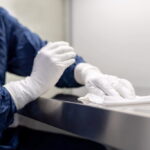One of the most common questions dentists/dental clinics get from patients is, “How to know if the dental lab is reputable?”
The concern is justified as dental restoration products like Dental Crown & Bridge Products are unlike any other cosmetic purchase. It will make or break how a person looks when they smile or bite food.
So, before you select a dental laboratory for your dental restoration orders, here are four questions you should definitely ask them.
#1 Do your products have ADA-approved materials?
If you are considering getting crowns and bridges, it is essential to ask the dental lab if their restoration materials are ADA-approved.
ADA stands for the American Dental Association – a non-profit organization that sets guidelines for safe practices in dentistry. You can trust that dental labs that use these standards have access to high-quality products and know how to use them properly.
Dental labs that use this certification can be trusted because they adhere to strict safety regulations when producing their materials.
#2 Does the dental lab use authentic manufacturer parts and hardware?
A dental lab should use authentic manufacturer parts and hardware when it comes to crowns and bridges. But what does this mean? It’s vital that the lab uses original parts from the manufacturer of your dental implants because they were explicitly designed for those specific implants.
Using authentic parts ensures the highest quality restoration by reducing risks such as –
- Long-term wear on your implant
- Infection caused by non-authentic materials (i.e., metal)
If you have questions about whether your dental lab uses authentic parts, be sure to ask them.
#3 What type of quality control checks are conducted?
Good quality control is critical for dental restorations. Asking about the lab’s quality control process will give you an idea of how much attention they pay to this part of the process. Ensure to enquire about –
- How often are quality control checks conducted on your products?
- What type of checks are conducted? Are they visual inspections? Do they involve measuring dimensions or checking tolerances?
- How do you review customer feedback and make changes to improve future products? If a customer finds a problem with one unit, does this directly impact production that same day or week?
- Does the lab have full-time employees who perform these tasks, or do you subcontract them?
#4 Do you outsource offshore companies to fulfill product orders?
Many of the products used in dental crowns and bridges are outsourced to countries with low labor and production costs, such as China or India.
Some labs do this without informing their dentist or the clinic at large. So, there is no way for you to know whether your lab is outsourcing its work overseas. It also leaves a question mark regarding what quality control processes are being put into practice.
Remember that the FDA does not have jurisdiction over foreign manufacturers – nor does the ADA require any particular standards from them regarding compliance laws.
Wrapping Up
Dental Crown & Bridge Products must be manufactured in the US to ensure that the products are safe and quality-checked. Choosing a dental lab that sends its orders to other countries should be avoided.
Many unknown risks are associated with using materials produced by foreign companies outside regulatory bodies. If customers get to know about this later, it can be an embarrassing ordeal for your dental clinic.
Read Also
- The Benefits of Contract Labor Staffing in Healthcare
 The most successful healthcare facilities today aren’t just reacting to crises—they are building workforce resilience to withstand them. Unpredictable patient demand, coupled with persistent nursing shortages, has made the traditional staffing model obsolete. Relying on mandatory overtime to cover a sudden surge in capacity is a recipe for high turnover and rising employee burnout relief… Read more: The Benefits of Contract Labor Staffing in Healthcare
The most successful healthcare facilities today aren’t just reacting to crises—they are building workforce resilience to withstand them. Unpredictable patient demand, coupled with persistent nursing shortages, has made the traditional staffing model obsolete. Relying on mandatory overtime to cover a sudden surge in capacity is a recipe for high turnover and rising employee burnout relief… Read more: The Benefits of Contract Labor Staffing in Healthcare - Management Reinforcement for Healthcare Providers in a Shifting System
 Healthcare is changing faster than ever. So, providers are feeling the pressure to keep up. New technology, changing patient needs, and constant rule updates make it tough for managers to stay on top. Strong leadership helps teams work better, give great care, and stay happy in their jobs. Here’s how healthcare leaders can strengthen their… Read more: Management Reinforcement for Healthcare Providers in a Shifting System
Healthcare is changing faster than ever. So, providers are feeling the pressure to keep up. New technology, changing patient needs, and constant rule updates make it tough for managers to stay on top. Strong leadership helps teams work better, give great care, and stay happy in their jobs. Here’s how healthcare leaders can strengthen their… Read more: Management Reinforcement for Healthcare Providers in a Shifting System - Why Effective Disinfection Remains the Foundation of Public Health
 From hospitals and schools to transport hubs and food production sites, disinfection is central to breaking the chain of infection and protecting community health. The COVID-19 pandemic highlighted how crucial surface hygiene and environmental control are in reducing the spread of harmful microorganisms. Yet, beyond emergency response, routine and validated disinfection practices remain the cornerstone… Read more: Why Effective Disinfection Remains the Foundation of Public Health
From hospitals and schools to transport hubs and food production sites, disinfection is central to breaking the chain of infection and protecting community health. The COVID-19 pandemic highlighted how crucial surface hygiene and environmental control are in reducing the spread of harmful microorganisms. Yet, beyond emergency response, routine and validated disinfection practices remain the cornerstone… Read more: Why Effective Disinfection Remains the Foundation of Public Health - How to Navigate Your Medical Assistant Career Path
 Becoming a medical assistant can feel both exciting and a little stressful. This job lets you work closely with doctors and other healthcare workers to help patients. But with so many different paths to take, it can be hard to know where to start or how to plan your career. Wouldn’t it be nice to… Read more: How to Navigate Your Medical Assistant Career Path
Becoming a medical assistant can feel both exciting and a little stressful. This job lets you work closely with doctors and other healthcare workers to help patients. But with so many different paths to take, it can be hard to know where to start or how to plan your career. Wouldn’t it be nice to… Read more: How to Navigate Your Medical Assistant Career Path - Benefits of Enrolling in Botox Training Courses
 Many people want to enhance their skills in the beauty field, and one way to do that is through Botox training. With the rising popularity of Botox, enrolling in training courses can set you on a path to a rewarding career. If you are considering this option, you might be curious about the benefits that… Read more: Benefits of Enrolling in Botox Training Courses
Many people want to enhance their skills in the beauty field, and one way to do that is through Botox training. With the rising popularity of Botox, enrolling in training courses can set you on a path to a rewarding career. If you are considering this option, you might be curious about the benefits that… Read more: Benefits of Enrolling in Botox Training Courses - How Pilates Certification Enhances Professional Growth in Healthcare
 Are you looking for a way to expand your skills and stand out in healthcare? Pilates certification can be a powerful step in your professional journey. It not only helps you understand movement and body mechanics. It also gives you tools to support patient recovery. It also improves mobility, and promotes wellness. Ready to see… Read more: How Pilates Certification Enhances Professional Growth in Healthcare
Are you looking for a way to expand your skills and stand out in healthcare? Pilates certification can be a powerful step in your professional journey. It not only helps you understand movement and body mechanics. It also gives you tools to support patient recovery. It also improves mobility, and promotes wellness. Ready to see… Read more: How Pilates Certification Enhances Professional Growth in Healthcare







